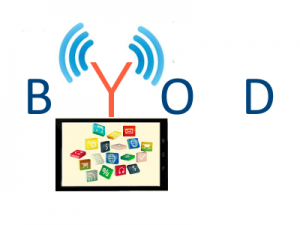Is BYOD a Concern?
BYOD – Bring Your Own Device, apparently, has become the new mantra in today’s workplace. Its benefits are appealing and attractive, but they also come with major threats and concerns. This post outlines some important facts about the BYOD program.
There is a reason Tim Cook (CEO of Apple Inc.) refers the present time as the “post-PC era”. The paradigm of communication and the ability to access data has seen a significant shift from computers to smartphones, tablets, and notebooks. And most organizations are using this shift to their advantage. With boom in smartphones, tablets and other mobile devices, most companies are readily embracing the BYOD trend that allows or encourages employees to use their personal devices to access enterprise data and systems. The time when organizations provided laptops, mobiles, etc., to their employees is but history.
And why not? BYOD has its own set of leverages:
• First, it boosts employees’ morale and thus increases productivity and ensures good retention rate. A survey conducted by iPass, a global leader in Wi-Fi connections for enterprise, revealed that employees who followed the BYOD trend, put in 240 extra hours in their work life.
• Second, it helps cut down on the company’s cost of buying and maintaining end user devices, as employees remain responsible for the same.
• Third, companies with a BYOD business model manage to attract newer employees, including top performers who seek work flexibility and are willing to put in more hours outside the traditional work hours.
But, the threats and concerns cannot be overlooked!
Despite being beneficial in terms of cost-cutting and staff flexibility, BYOD has its own share of drawbacks.
• Network breach is the first and foremost security concern that looms over companies following the BYOD trend. With myriad devices connected to the company’s network, the security risk is gigantic. Even a single malware-infected device of an employee can bring down the entire network resulting in confidential data breach, theft and other major losses.
• Mobile theft or loss is another concern. According to police figures, as much as 300,000 mobile phones are stolen every year. If an employee’s phone or tablet gets into the wrong hands, not only their sensitive information but also that of the company is at stake. And it goes without saying, there is no dearth of people or “bodies” who trade such sensitive corporate data for handsome rewards.
• Following the BYOD trend also puts the employee’s personal data at risk. In a scenario where an employee’s device is lost or stolen, the company might decide to wipe the device clean. Although this may keep the company’s sensitive data from getting into the wrong hands, it gets rid of the employee’s personal info which may include images, videos, important health records, etc.
Measures that Can Be Considered
If BYOD is implemented, then it is imperative to devise a BYOD policy for the employees. Some key points that the policy could include are:
• Educating employees about the importance of placing stronger passwords, and using reliable security software for their devices and keeping the software updated.
• Putting a process in place that would authenticate employees and their respective devices. This would avoid multiple devices from being used by random people.
• Enforcing a policy of data encryption.
• Helping employees understand how crucial it is to protect their devices from theft or loss, not only because it is their personal property, but also because they carry the company’s sensitive data.
• Giving employees an option to back out from the BYOD trend when they wish to. However, a set of protocols must be put in place for this, as at some point of time, their devices did get involved in official work.
• Implementing Mobile Device Management (MDM) that can wipe data from stolen or lost mobile devices.
Quick Heal Mobile Security Solutions help mitigate BYOD risks such as malware-infection of mobile devices that access corporate network. The solutions are available across Android and Blackberry platforms.

1 Comment